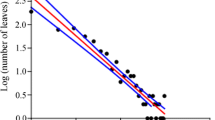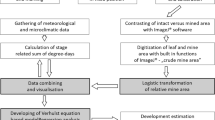Summary
The study of the population dynamics of the celery leaf-miner,Philophylla heraclei, must take into account the fact that the host-plant is not present permanently and that it develops between the two annual generations of the insect. This development affects in particular the quality and quantity of the leaves fed upon by the mining larvae. It is possible to know the numerical change of the populations from one annual generation to the next (bivoltine insect) and from one year to the next by counting the populations in the various larval instars, responsible for the injury caused to celery.
An accurate method of counting of larval numbers, taking into account their change parallel with that of the host-plant, is described in this text. It makes it possible to know with accuracy the duration and importance of the infestations in relation to external factors and to factors inherent to the host-plant itself. Certain traits of larval behaviour, particularly the transfer of a larva from its original mine to a secondary mine as a result of food shortage can thus be established and estimated quantitatively.
Similar content being viewed by others
References
Feeny, P. P. (1968) Effect of oak leaf tannins on larval growth of the winter moth.Operophtera brumata.J. Insect. Physiol.14: 805–817.
Feeny, P. P. (1970) Seasonal changes in oak leaf tannins and nutrients as a cause of spring feeding by winter moth caterpillarsEcology51: 565–581.
Hillyer, R. J. andThorsteinson, A. J. (1969) The influence of host plant or males on ovarian development or oviposition in the diamondback moth.Plutella maculipennis. Canad. J. Zool.47: 805–816.
Hudon, M. andLe Roux, E. J. (1961) Variation between samples of immature stages, and of mortalities from some factors, on the European Corn Borer,Ostrinia nubilalis (Lepidopt., Pyralidea), on sweet corn in Quebec.Canad. Ent.93: 867–888.
Keilin, D. andTate, P. (1943) The larval stages of the celery fly (Acidia heraclei L.) and of BraconidAdelura apii (Curtis), with notes upon an associated parasitic yeast-like fungus.Parasitology35: 27–36.
Labeyrie, V. (1957) Observations sur le comportement de ponte de la Mouche du céleri (Philophylla heraclei).Ann. Epiph.11: 171–183.
Labeyrie, V. (1958) Observations sur l’écologie de la Mouche du céleri (Philophylla heraclei L.) dans le Bordelais.Rev. Zool. Agric. appl.7–9: 1–4.
Monchadsky, A. S. (1962) Facteurs écologiques et principes de leur classification.J. Biol.23: 370–380.
Morris, R. F. (1960) Sampling insect populations.Ann. Rev. Ent.5: 243–264.
Southwood, T. R. E. andJepson, W. F. (1962) Studies on the populations ofOscinella frit (Diptera, Chloropidae), in the oat crop.J. Anim. Ecol.31: 481–495.
Varley, G. C. (1970) The concept of energy flow applied to a woodland community.British Ecol. Soc. Symp., No.10: 389–405.
DeWilde, J., Bongers, W. andSchooneveld, H. (1969) Effects of host plant age on phytophagous insects.Ent. Exp. & Appl.12: 714–720.
Author information
Authors and Affiliations
Rights and permissions
About this article
Cite this article
Leroi, B. A study of natural populations of the celery leaf-minerPhilophylla heraclei L. (Diptera, Tephritidae). Res Popul Ecol 13, 201–215 (1972). https://doi.org/10.1007/BF02521978
Issue Date:
DOI: https://doi.org/10.1007/BF02521978




